

Commensal Fungi in Health and Disease. Pandemic phase descriptions and actions. Definition of subclinical infection by Medical dictionary. Invasionandmultiplication of microorganisms in bodytissues, as in an infectiousdisease.Theinfectiousprocess is similar to a circularchainwitheachlinkrepresentingone of thefactorsinvolved in theprocess.

The spectrum of infectious agents changes with the passage of time and the introduction of drugs and chemicals designed to destroy them. The advent of antibiotics and the resultant development of resistant strains of bacteria have introduced new types of pathogens little known or not previously thought to be significantly dangerous to man. A few decades ago, gram-positive organisms were the most common infectious agents. Today the gram-negative microorganisms, and Proteus, Pseudomonas, and Serratia are particularly troublesome, especially in the development of hospital-acquired infections. Australian Health Management Plan for Pandemic Influenza (AHMPPI) Foreword to the AHMPPI The Australian Government is committed to keeping Australia secure against potential threats.
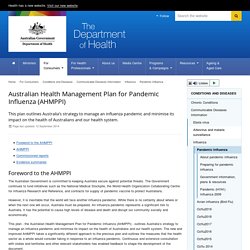
The Government continues to fund initiatives such as the National Medical Stockpile, the World Health Organization Collaborating Centre for Influenza Research and Reference, and contracts for supply of pandemic vaccine to protect Australians. However, it is inevitable that the world will face another influenza pandemic. While there is no certainty about where or when the next one will occur, Australia must be prepared. An influenza pandemic represents a significant risk to Australia. Welcome - ASPREN. Why it's your job to get a flu shot – and call in sick if you do get the flu. Seasonal influenza is a major global health concern.
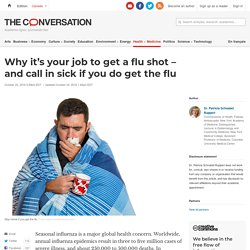
Worldwide, annual influenza epidemics result in three to five million cases of severe illness, and about 250,000 to 500,000 deaths. In industrialized countries, most deaths associated with influenza occur among people age 65 or older, who are also 10-30 times more likely to be hospitalized due to influenza-related complications. In the United States, the overall burden of influenza disease during 2014-2015 across all ages was 40 million flu illnesses, 19 million flu-associated medical visits and 970,000 flu-associated hospitalizations resulting in more than 36,000 deaths due to influenza-related complications.
You play an important role in stopping the spread of flu, not just to yourself but to others. WHO Collaborating Centre for Influenza - WHO Global Influenza Surveillance Network. WHO Global Influenza Surveillance Network (GISN) Surveillance and Vaccine Development The WHO Global Influenza Surveillance Network (GISN) monitors which influenza viruses are circulating in humans around the world throughout the year.

GISN comprises: 5 WHO Collaborating Centres (Atlanta, Beijing, London, Melbourne, Tokyo) 136 National Influenza Centres in 106 countries 11 H5 Reference Laboratories 4 Essential Regulatory Laboratories The major technical roles of GISN are to: Tracking Influenza Across Australia and New Zealand. The rise and fall of infectious diseases: Australian perspectives, 1914-2014. In 1914, when the British Medical Association launched the Medical Journal of Australia, the medical profession and the general public believed that infectious diseases would soon be conquered.

Acrimonious 19th century disputes between the contagionists and the sanitarians1 had given way to an alliance which was steadily improving health. 7. Australian Quarantine Service. Maritime quarantine administration. Melbourne: Arthur J Mullett, Government Printer, 1919. 6. 5. A strong immune system helps ward off colds and flus, but it's not the only factor. It’s peak flu season.
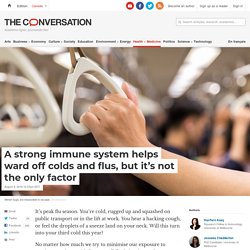
You’re cold, rugged up and squashed on public transport or in the lift at work. You hear a hacking cough, or feel the droplets of a sneeze land on your neck. Australian Infection Prevention and Control Guidelines. About. VIDRL is a leading Australian infectious diseases reference laboratory located in Melbourne, Victoria.

VIDRL is now part of the Peter Doherty Institute for Infection and Immunity (the Doherty). VIDRL provides the Victorian Department of Health with virology and Mycobacteria public health reference laboratory services, including surveillance, outbreak investigations, reference testing and research. VIDRL also performs diagnostic testing, mainly in virology, for Victorian hospitals. VIDRL has national reference laboratory designations to the Commonwealth Department of Health for polio and enteroviruses, measles, viral haemorrhagic fevers and smallpox. Communicable Diseases Weekly Report (CDWR) - Reports. Chapter 7: Outbreak investigation. Australian Influenza Surveillance Report and Activity Updates. Horror flu outbreak sends nursing home into lockdown. Influenza vaccines for Australians - FAQs. Fighting the flu can be a matter of life and death – so what more can we do?
As Australia endures one of its worst flu seasons in more than a decade, questions are being raised about how the public can be better prepared and what can be done to protect the most vulnerable.
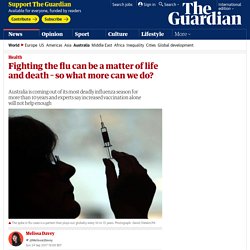
At least 170,000 influenza cases have been confirmed this season, almost two-and-a-half times more than in 2016. The federal health department logged 72 flu-related deaths by Thursday, including that of eight-year-old Rosie Andersen in Melbourne. Experts say Australia is on track for a record number of confirmed cases. Sarah Hawthorn, from the regional town of Cobram in northern Victoria, remains in a critical condition in hospital after contracting the flu late in her pregnancy. After giving birth to a healthy boy, she was placed in an induced coma.
Despite tragic cases such as these, the spike in flu cases is a pattern that plays out globally every 10 to 15 years. Measles and Rubella Surveillance Data. Department of Health. Measles (Rubeola) Verification of measles elimination in Australia: Application of World Health Organization regional guidelines. 1.
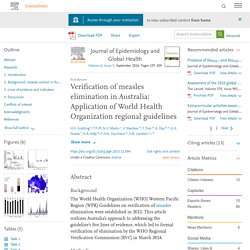
Introduction Globally, efforts to control measles have been very effective, with a 74% reduction in measles-related mortality between 2000 and 2010 [1]. Sustained high coverage with a two-dose vaccination schedule resulted in elimination of endemic measles from the Americas between 2002 and 2013 (since then endemic transmission has been reestablished in Brazil), and in individual countries from other regions [2]. These successes led the World Health Organization (WHO) to conclude that measles eradication (interruption of measles transmission globally) is feasible and cost effective [3] and all six WHO regions have set elimination targets [2].
In 2010, the Western Pacific Region (WPR) reaffirmed its goal of measles elimination by 2012. 4. This is the first report to document the application of the WPR RVC guidelines for the elimination of measles in a Western Pacific country. Even though Australia has eliminated measles, there remain some concerning immunity gaps. Not all parents vaccinate their kids. But that doesn't mean they're anti-vaxxers. Updated about 6 hours agoSat 19 Oct 2019, 2:54am While most Australian parents vaccinate their children, there's still a minority who don't — but they're not all vehement anti-vaccination activists.

In fact, most non-vaccinating parents are simply "trying to get on with the job of parenting", says Julie Leask, a social scientist at the University of Sydney's Nursing School who researches people's attitudes to vaccines. "Vaccine refusal is a problem for public health so it's important to have high vaccination rates. But the national conversation has become fraught," she says. "Our research is trying to figure out how best to work with those parents to create a more productive way forward. " IMMU VS ADULTS 3pt 0219r. TGA eBS - Product and Consumer Medicine Information Licence. Access Terms for Product Information and Consumer Medicine Information Documents ("Licence") Parties You or Your means any legal person or entity who accesses or downloads a PI Document or CMI Document from Our website and Us, We or Our means the Commonwealth of Australia as represented by the Therapeutic Goods Administration ABN 40 939 406 804 of 136 Narrabundah Lane, Symonston ACT 2609, Australia.
TGA eBS - Product and Consumer Medicine Information Licence. Access Terms for Product Information and Consumer Medicine Information Documents ("Licence") Parties You or Your means any legal person or entity who accesses or downloads a PI Document or CMI Document from Our website and Us, We or Our means the Commonwealth of Australia as represented by the Therapeutic Goods Administration ABN 40 939 406 804 of 136 Narrabundah Lane, Symonston ACT 2609, Australia. TGA eBS - Product and Consumer Medicine Information Licence. Access Terms for Product Information and Consumer Medicine Information Documents ("Licence") Parties You or Your means any legal person or entity who accesses or downloads a PI Document or CMI Document from Our website and Us, We or Our means the Commonwealth of Australia as represented by the Therapeutic Goods Administration ABN 40 939 406 804 of 136 Narrabundah Lane, Symonston ACT 2609, Australia.
Tuberculosis. Tuberculosis (TB) is caused by bacteria (Mycobacterium tuberculosis) that most often affect the lungs. Tuberculosis is curable and preventable. TB is spread from person to person through the air. When people with lung TB cough, sneeze or spit, they propel the TB germs into the air. A person needs to inhale only a few of these germs to become infected.
About one-quarter of the world's population has a TB infection, which means people have been infected by TB bacteria but are not (yet) ill with the disease and cannot transmit it. People infected with TB bacteria have a 5–15% lifetime risk of falling ill with TB. When a person develops active TB disease, the symptoms (such as cough, fever, night sweats, or weight loss) may be mild for many months. Tuberculosis testing. Chris Coulter This article forms part of our 'Tests and results' series for 2012, which aims to provide information about common tests that general practitioners order regularly. It considers areas such as indications, what to tell the patient, what the test can and cannot tell you, and interpretation of results. Tuberculosis (TB) is estimated to infect a third of the world's population, but the possibility of TB as a diagnosis may be forgotten in Australia where the overall incidence is low; about 1000 cases are diagnosed nationally each year and the incidence is 5-6 per 100 000 population.1 Patients born, raised or recently arrived from high TB-burden countries, and patients from some indigenous communities, are at much higher risk of contracting TB.
After infection, TB may remain latent for many years, re-emerging with immunosuppression or advancing age. Exogenous reinfection in tuberculosis. Exogenous re-infection and the dynamics of tuberculosis epidemics: local effects in a network model of transmission. VacMap. Staphylococcal infections. Notification requirement for staphylococcal infections. Woman killed from lethal bacteria after cat licked her. Doctors are warning people about the dangers of cat saliva after a woman died from her pet licking her. Endogenous vs. Exogenous Infections: It's All About Crowd Control. Are all hospital-acquired infections due to contaminated surfaces?